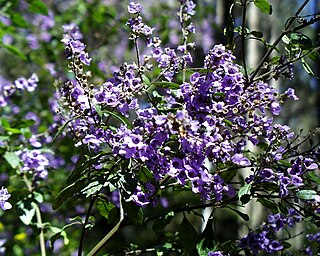
Prostanthera melissifolia, commonly known as balm mint bush, is a species of flowering plant in the family Lamiaceae and is endemic to south-eastern Australia. It is an erect shrub with hairy branches, egg-shaped leaves with fine teeth on the edges and mauve to purple or pink flowers on the ends of branchlets.
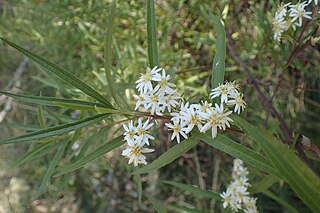
Olearia viscidula, commonly known as the viscid daisy bush or wallaby weed, is a species of flowering plant in the family Asteraceae and is endemic to eastern New South Wales. It is a shrub with scattered narrow elliptic or egg-shaped leaves that are paler on the lower surface, and panicles of white flowers arranged in leaf axils.

Brachyscome multifida is a perennial herb in the family Asteraceae. Common names include cut-leaved daisy, rocky daisy, and Hawkesbury daisy. The species is endemic to Australia.

Spathoglottis paulinae, commonly known as the small purple orchid, is a plant in the orchid family and is native to New Guinea and Tropical North Queensland. It is an evergreen terrestrial orchid with crowded pseudobulbs, between four and seven large, pleated leaves and up to thirty mauve to purple flowers.

Olearia asterotricha, commonly known as rough daisy-bush, is a species of flowering plant in the family Asteraceae. A tall shrub with white, mauve or blue daisy like flowers growing from the Blue Mountains in New South Wales to western Victoria, Australia.
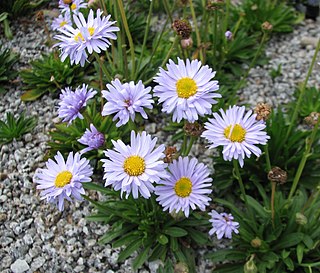
Brachyscome scapigera, commonly known as tufted daisy, is a perennial herb in the family Asteraceae. The species is endemic to south-eastern Australia.

Dipodium ensifolium, commonly known as leafy hyacinth-orchid, is an orchid species that is endemic to north-east Queensland. It has sword-shaped leaves and up to twenty pink to mauve flowers with purplish spots and blotches.

Thelymitra × macmillanii, commonly called the red sun orchid or crimson sun orchid is a species of orchid that is endemic to south-eastern Australia. It has a single tapering, channelled leaf and up to five bright red, sometimes yellow flowers. It is a natural hybrid between T. antennifera and T. carnea or T. rubra.
Nervilia holochila, commonly known as the ribbed shield orchid, is a small terrestrial orchid found in northern Australia. It has up to six pink, greenish or cream-coloured, short-lived flowers with a pink to mauve labellum. A dark green, egg-shaped leaf emerges at the base of the flowering stem after flowering.
Nervilia uniflora, commonly known as the red shield orchid, is a small terrestrial orchid found in northern Queensland. It has a single short-lived, pink or mauve flower. A dark green, heart-shaped leaf emerges at the base of the flowering stem after flowering.
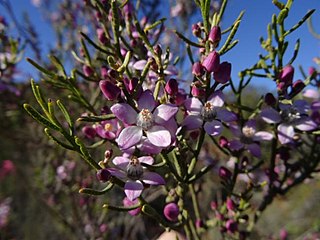
Philotheca brucei is a species of flowering plant in the family Rutaceae and is endemic to Western Australia. It is a shrub with cylindrical leaves grooved along the top and in spring, white to pink or mauve flowers with five egg-shaped petals.

Olearia magniflora, commonly known as the splendid daisy-bush, is a small shrub with clusters of deep mauve to purple flowers.
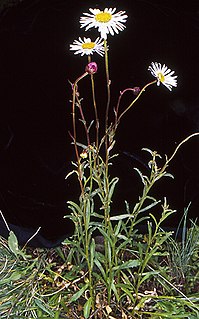
Brachyscome aculeata, commonly known as hill daisy is a tufted perennial herb in the family Asteraceae and is endemic to Australia. It has mostly white daisy-like flowers, a yellow centre, variable shaped leaves and flowers in spring to autumn.

Brachyscome ascendens, the border ranges daisy, is a species of flowering plant in the family Asteraceae and is endemic to Australia. It has mostly mauve daisy-like flowers and a yellow centre.

Brachyscome basaltica, commonly known as swamp daisy, is a perennial herb in the family Asteraceae and is endemic to Australia. It has mostly white daisy-like flowers and a yellow centre.
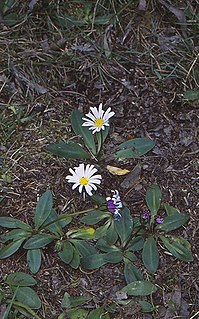
Brachyscome decipiens, commonly known as field daisy is a perennial herb in the family Asteraceae and is endemic to Australia. It is a small herb with white or pale blue flowers.

Brachyscome dentata, commonly known as lobe-seed daisy, is a tufted perennial herb in the family Asteraceae and is endemic to Australia. It has mostly white or mauve daisy-like flowers, a yellow centre and pale green leaves. It is endemic to Australia.
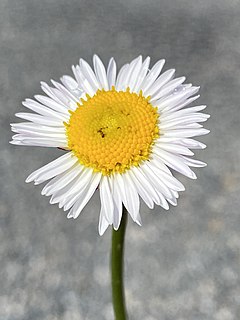
Brachyscome nivalis, commonly known as snow daisy, is a perennial herb in the family Asteraceae and is endemic to Australia. It has mostly white daisy-like flowers, yellow centres and deeply lobed leaves.

Goodenia eatoniana is a species of flowering plant in the family Goodeniaceae and is endemic to the extreme south-west of Western Australia. It is a perennial herb with lance-shaped leaves at the base of the plant, egg-shaped stem leaves, and racemes of blue flowers.
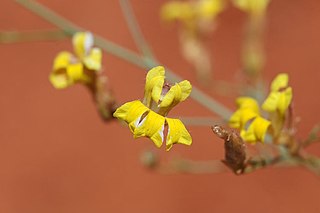
Goodenia lamprosperma is a species of flowering plant in the family Goodeniaceae and is endemic to northern Australia. It is an annual or perennial herb with linear to lance-shaped leaves sometimes with teeth on the edges, and racemes of yellow flowers.


















